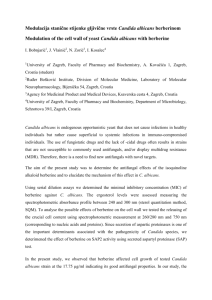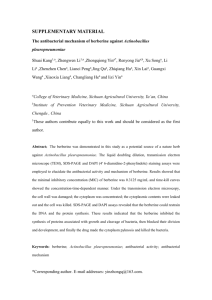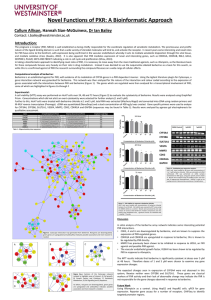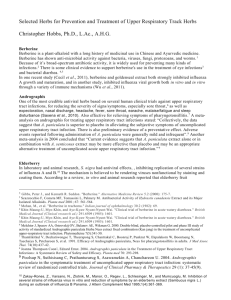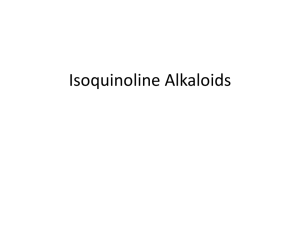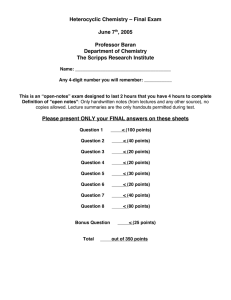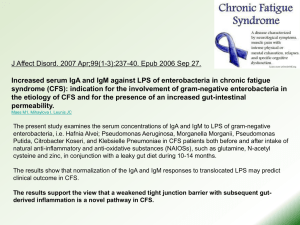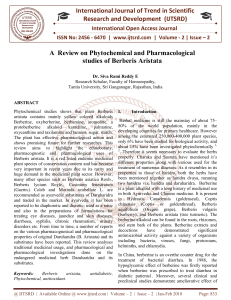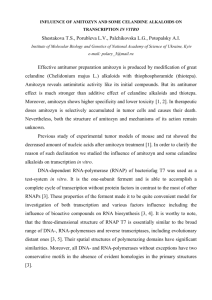Document 13309118
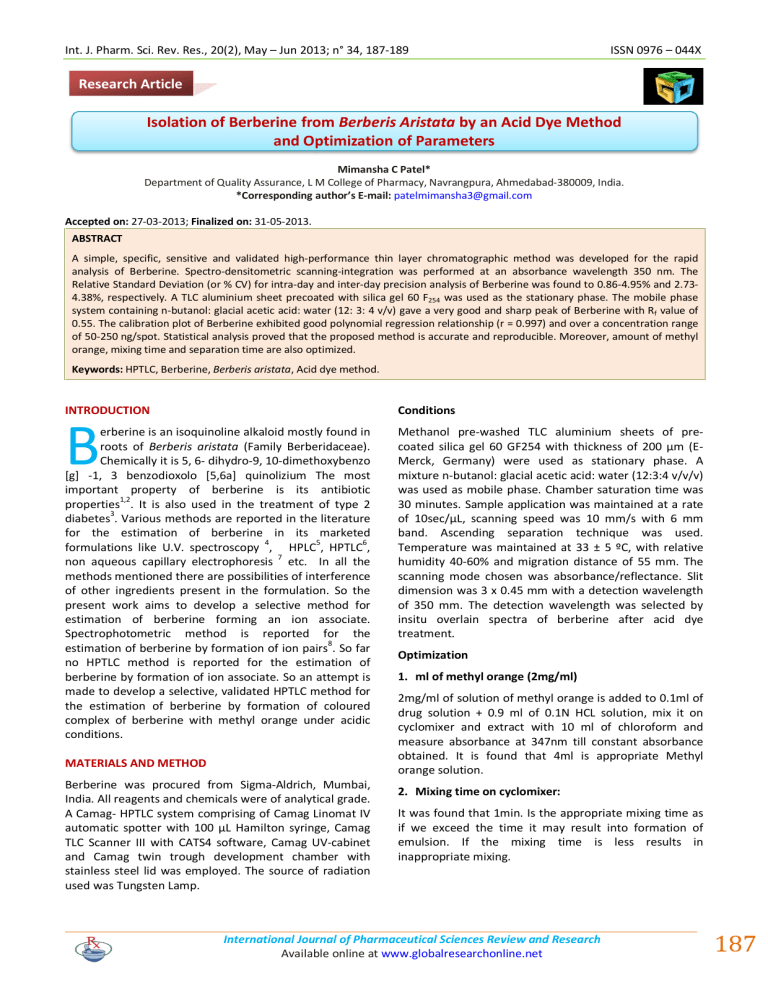
Int. J. Pharm. Sci. Rev. Res., 20(2), May – Jun 2013; n° 34, 187-189 ISSN 0976 – 044X
Research Article
Isolation of Berberine from Berberis Aristata by an Acid Dye Method and Optimization of Parameters
Mimansha C Patel*
Department of Quality Assurance, L M College of Pharmacy, Navrangpura, Ahmedabad-380009, India.
*Corresponding author’s E-mail: patelmimansha3@gmail.com
Accepted on: 27-03-2013; Finalized on: 31-05-2013.
ABSTRACT
A simple, specific, sensitive and validated high-performance thin layer chromatographic method was developed for the rapid analysis of Berberine. Spectro-densitometric scanning-integration was performed at an absorbance wavelength 350 nm. The
Relative Standard Deviation (or % CV) for intra-day and inter-day precision analysis of Berberine was found to 0.86-4.95% and 2.73-
4.38%, respectively. A TLC aluminium sheet precoated with silica gel 60 F
254
was used as the stationary phase. The mobile phase system containing n-butanol: glacial acetic acid: water (12: 3: 4 v/v) gave a very good and sharp peak of Berberine with R f
value of
0.55. The calibration plot of Berberine exhibited good polynomial regression relationship (r = 0.997) and over a concentration range of 50-250 ng/spot. Statistical analysis proved that the proposed method is accurate and reproducible. Moreover, amount of methyl orange, mixing time and separation time are also optimized.
Keywords: HPTLC, Berberine, Berberis aristata, Acid dye method.
INTRODUCTION
B erberine is an isoquinoline alkaloid mostly found in roots of Berberis aristata (Family Berberidaceae).
Chemically it is 5, 6- dihydro-9, 10-dimethoxybenzo
[g] -1, 3 benzodioxolo [5,6a] quinolizium The most important property of berberine is its antibiotic properties
1,2
. It is also used in the treatment of type 2 diabetes
3
. Various methods are reported in the literature for the estimation of berberine in its marketed formulations like U.V. spectroscopy
4
, HPLC
5
, HPTLC
6
, non aqueous capillary electrophoresis
7
etc. In all the methods mentioned there are possibilities of interference of other ingredients present in the formulation. So the present work aims to develop a selective method for estimation of berberine forming an ion associate.
Spectrophotometric method is reported for the estimation of berberine by formation of ion pairs
8
. So far no HPTLC method is reported for the estimation of berberine by formation of ion associate. So an attempt is made to develop a selective, validated HPTLC method for the estimation of berberine by formation of coloured complex of berberine with methyl orange under acidic conditions.
MATERIALS AND METHOD
Berberine was procured from Sigma-Aldrich, Mumbai,
India. All reagents and chemicals were of analytical grade.
A Camag- HPTLC system comprising of Camag Linomat IV automatic spotter with 100 µL Hamil ton syringe, Camag
TLC Scanner III with CATS4 software, Camag UV-cabinet and Camag twin trough development chamber with stainless steel lid was employed. The source of radiation used was Tungsten Lamp.
Conditions
Methanol pre-washed TLC aluminium sheets of precoated silica gel 60 GF254 with thickness of 200 µm (E -
Merck, Germany) were used as stationary phase. A mixture n-butanol: glacial acetic acid: water (12:3:4 v/v/v) was used as mobile phase. Chamber saturation time was
30 minutes. Sample application was maintained at a rate of 10sec/µL, scanning speed was 10 mm/s with 6 mm band. Ascending separation technique was used.
Temperature was maintained at 33 ± 5 ºC, with relative humidity 40-60% and migration distance of 55 mm. The scanning mode chosen was absorbance/reflectance. Slit dimension was 3 x 0.45 mm with a detection wavelength of 350 mm. The detection wavelength was selected by insitu overlain spectra of berberine after acid dye treatment.
Optimization
1.
ml of methyl orange (2mg/ml)
2mg/ml of solution of methyl orange is added to 0.1ml of drug solution + 0.9 ml of 0.1N HCL solution, mix it on cyclomixer and extract with 10 ml of chloroform and measure absorbance at 347nm till constant absorbance obtained. It is found that 4ml is appropriate Methyl orange solution.
2.
Mixing time on cyclomixer:
It was found that 1min. Is the appropriate mixing time as if we exceed the time it may result into formation of emulsion. If the mixing time is less results in inappropriate mixing.
International Journal of Pharmaceutical Sciences Review and Research
Available online at www.globalresearchonline.net
187
Int. J. Pharm. Sci. Rev. Res., 20(2), May – Jun 2013; n° 34, 187-189 ISSN 0976 – 044X
3.
Separation time:
For proper extraction of drug in organic layer 20mins time is required to get proper separation between organic layer & aqueous layer.
Isolation of Berberine
Berberine was extracted from powder of Berberis aristata roots by Soxhlet apparatus. The ethanolic extract is concentrated on hot water bath till syrupy mass obtained.
Dissolve in 25ml of hot water and filter it with Whatmann filter paper. Add 5ml hot water to the residual syrupy mass, again filter it. To the combined filtrate add slowly while shaking 15ml of strong HCL (36.5%w/v). Cool it on ice bath for about 30 mins. or place it in refrigerator for overnight. After cooling filter the contents, wash the crystals of filter paper with water.
Preparation of solution
For preparation of solution 4gm of powder weighed accurately and transfer to beaker imbibe with optimum amount of strong ammonia for overnight. Dry it and extract with 50ml of 80% ethanol by refluxing on water bath for 1and half hour. It was filtered, transfer filtrate to
10ml of volumetric flask and make up the volume. 0.1 ml of the solution is transferred to test tube, add 1.9ml of
0.1N HCL and 4 ml of methyl orange add (3+3+4ml) of chloroform and shake on cyclo-mixer for 1 min., pipette out Chloroform layer in 10ml of volumetric flask, make up the volume with chloroform. The final chloroform solution of each sample was used for the assay analysis.
Method of analysis
Aliquots of 5, 10, 15, 20 and 25µl of berberine working solution (10µg/ml) corresponding to 50, 100, 150, 200,
250ng of berberine/spot were applied on pre-washed and activated TLC plate with the help of semi automatic spotter under nitrogen stream. The plate was dried and developed in previously saturated twin trough chamber at constant temperature 33±5 ˚C using n -butanol:acetic acid: water (12:3:4) as mobile phase. After development plate is dried and photometrically analysed at 350nm wavelength. Calibration curve was prepared by plotting respective peak areas of berberine against concentration
The proposed method was validated as per ICH guidelines. The formation of a coloured complex of berberine with methyl orange under acidic condition minimized the interference of the other amines and alkaloids present in the samples. The mobile phase system containing n-butanol: glacial acetic acid: water
(12: 3: 4 v/v) gave a good resolution sharp peak of
Berberine with R f
value of 0.55 (Fig 1). The method was found to be specific. No interference of other ingredients was found in the analysis of berberine in root powder of
Berberis aristata (Fig 1).
RESULTS AND DISCUSSION
The calibration plot of Berberine exhibited polynomial regression relationship (r = 0.997) over a concentration range of 50-250 ng/spot. The polynomial regression analysis minimized sampling error and analysis of sample was possible for a wider range of concentration. The accuracy of the proposed method was ascertained by carrying out the recovery study at three different levels
(50, 100, 150 %). The accuracy was found to be in the range of 100.32-101.64%. The inter day and intra day precision was carried out and the results were reported in terms of RSD (Table 1). The limit of detection and limit of quantitation was found to be 5ng/spot and 10 ng/spot respectively. The summary of validation parameter is shown in Table 1.
Figure 1: Chromatogram showing peaks of berberine along with methyl orange (a) 50ng, (b) 100ng, (c) 150ng,
(d) 200ng, (e) 250ng at 350 nm after treatment with methyl orange. Peak 1 in all the tracks indicate that of berberine and peak 2 in all the tracks is of methyl orange.
Parameter
Linearity range
Coefficient of correlation
Specificity
Intra day Precision (%C.V)
Inter day Precision(%C.V)
CONCLUSION
Table 1: Validation Parameters
The developed HPTLC method is simple, accurate, precise and specific for the estimation of berberine. The proposed method is successfully used for the estimation of berberine. It was found that the acid dye method used minimizes the interference of other closely related constituents.
REFERENCES
1.
Sun D, Abraham SN, and Beachey EH. Influence of berberine sulfate on synthesis and expression of Pap fimbrial adhesin in uropathogenic Escherichia coli.
Antimicrob Agents Chemother, 32(8), 1988, 1274–1277.
2.
Amin AH, Subbaiah TV and Abbasi KM. Berberine
Sulphate: antimicrobial action, bioassay and mode of action. Can. J. Microbiol, 15, 1969, 1067-1076.
International Journal of Pharmaceutical Sciences Review and Research
Available online at www.globalresearchonline.net
Value
50-250 ng/spot.
0.997
Specific
0.86-4.95%
2.73-4.38%
188
Int. J. Pharm. Sci. Rev. Res., 20(2), May – Jun 2013; n° 34, 187-189 ISSN 0976 – 044X
3.
Tang LQ, Wei W, Chen LM and Liu S. Effects of berberine on diabetes induced by alloxan and a high-fat/highcholesterol diet in rats. J. Ethnopharmacol, 108, 2006,
109-115.
4.
Chen L, Yantao L, Shen X and Zhang L . Determination of
Berberine Hydrochloride in Berberine Prickly- heat
Powder by UV Spectrophotometry. China
Pharmaceuticals, 16(21), 2007, 1903.
5.
Ya SU, Min LU. Determination of hydrochloric berberine in
Quban powder by HPLC. Strait Pharmaceutical J, 3, 2009,
20.
6.
Rout KK, Pradhan S, Mishra SK. Estimation of berberine in ayurvedic formulations containing Berberis aristata. J.
AOAC Int, 91, 2008, 1149-1153.
7.
Dong YM, Chen XF, Chen, XG. Rapid determination of berberine in Tianshen capsule by nonaqueous capillary electrophoresis. J. Lanzhou University Natural Sciences,
42, 2006, 73-77.
8.
Sakai T, Ohno N, Sasaki H and Hyuga T. Extraction-
Spectrophotometric Determination of Berberine in Crude
Drugs by the Formation of a New Ion Associate. Analytical
Sciences, 7(1), 1991, 39.
9.
Upwar N K, Patel R, Waseem, Mahobi N K. Hypoglycemic effect of methanolic extract of Berberis aristata dc stem on normal and stretozotocin induced diabetic rats. J. of
Pharmacy and Pharm. Sciences, 3(1), 2011, 222-224.
10.
Adikay S, Koganti B, Prasad, KVSRG. Effect of decoction of root bark of berberis aristata against cisplatin-induced nephrotoxicity in rats. J. of Pharmacy and Pharm.
Sciences, 2(3), 2010, 51-56.
Source of Support: Nil, Conflict of Interest: None.
International Journal of Pharmaceutical Sciences Review and Research
Available online at www.globalresearchonline.net
189
